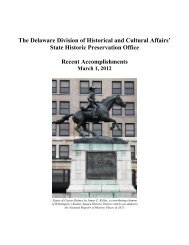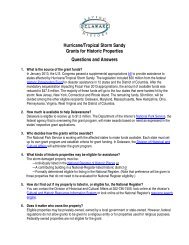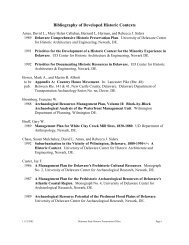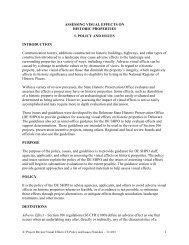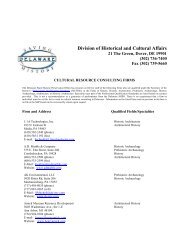Report of the Archaeological Investigations of the New Castle Court ...
Report of the Archaeological Investigations of the New Castle Court ...
Report of the Archaeological Investigations of the New Castle Court ...
Create successful ePaper yourself
Turn your PDF publications into a flip-book with our unique Google optimized e-Paper software.
NEW CASTLE COURT HOUSE PLAZA<br />
NEW CASTLE, DELAWARE<br />
3.0 FIELD RESULTS<br />
Feature 65<br />
Feature 65 may represent a section <strong>of</strong> builder’s trench associated with <strong>the</strong> circa 1820 retaining<br />
wall within EUs 27 and 28. This feature was not excavated.<br />
3.5.10 PORTICO FOUNDATION<br />
Feature 78 represents <strong>the</strong> mortared stone portico foundation that straddles <strong>the</strong> front steps to <strong>the</strong><br />
circa 1732 block. The portico is reported as being removed from <strong>the</strong> <strong>Court</strong> House in 1936. It<br />
measures approximately 11.5 by 9.4 ft. and extends from <strong>the</strong> foundation <strong>of</strong> <strong>the</strong> original block to<br />
<strong>the</strong> nor<strong>the</strong>rn interior edge <strong>of</strong> <strong>the</strong> circa 1820 plaza retaining wall (Plate 16). The feature was<br />
identified during <strong>the</strong> stripping <strong>of</strong> <strong>the</strong> center plaza. A total <strong>of</strong> seven artifacts were recovered from<br />
<strong>the</strong> fill deposits overlying <strong>the</strong> portico foundation. Recovered items include one redware sherd, a<br />
clear unidentified bottle glass fragment, three cut/wrought nails, and two wire nails. In addition, a<br />
machine-made Coke bottle dating to 1957 and a round graphite pencil fragment were recovered<br />
directly atop <strong>the</strong> foundation stone. The coke bottle may in fact relate to <strong>the</strong> 1950 <strong>Court</strong> House<br />
restoration (see concrete footer discussion).<br />
3.5.11 POST HOLES<br />
A total <strong>of</strong> 56 post features were identified within <strong>the</strong> plaza representing 58.3 percent <strong>of</strong> <strong>the</strong> total<br />
feature count. Only 8.9 percent, or 5 <strong>of</strong> <strong>the</strong> 56 post holes, were identified as containing an<br />
associated mold stain (Features 2, 31, 51, 67, and 82). It is also interesting to note that 84 percent<br />
(47 post holes) are located within 5 ft. <strong>of</strong> <strong>the</strong> exterior <strong>Court</strong> House foundation (Figures 5 and 6).<br />
This close proximity, in addition to a lack <strong>of</strong> mold stains within <strong>the</strong> majority <strong>of</strong> post holes, may<br />
indicate that <strong>the</strong>se features relate to temporary construction activities such as falsework (i.e.;<br />
workers’ scaffolding ) and not to any longer-lasting architectural feature. One such type <strong>of</strong><br />
falsework, referred to as “bricklayers’ scaffolding” utilizes <strong>the</strong> brick masonry wall and one set <strong>of</strong><br />
wooden standards or posts in its construction with putlogs inserted in voids purposefully left in<br />
<strong>the</strong> masonry to receive <strong>the</strong>m (Fitchen 1992:85-86). The wooden standards or posts were placed in<br />
shallow excavated holes while in use <strong>the</strong>n were removed when <strong>the</strong> construction <strong>of</strong> <strong>the</strong> <strong>Court</strong><br />
House was completed.<br />
Within <strong>the</strong> eastern section <strong>of</strong> <strong>the</strong> plaza, 88.5 percent <strong>of</strong> <strong>the</strong> posts were identified at <strong>the</strong> interface<br />
with <strong>the</strong> underlying subsoil, indicating that <strong>the</strong> majority predate <strong>the</strong> construction <strong>of</strong> <strong>the</strong> circa 1820<br />
plaza. Features 5, 8, and 9 were <strong>the</strong> only noted exceptions; <strong>the</strong>se were identified above <strong>the</strong><br />
subsoil, within or above <strong>the</strong> lower sand layer on <strong>the</strong> eastern plaza. Seven <strong>of</strong> <strong>the</strong> posts were<br />
sampled and only one <strong>of</strong> <strong>the</strong> features yielded a dateable artifact. A TPQ <strong>of</strong> 1670 was assigned to<br />
Feature 10.<br />
Identification <strong>of</strong> post holes within <strong>the</strong> western plaza occurred much higher in <strong>the</strong> stratigraphic fill<br />
sequence indicating that more construction or restoration has occurred within this portion <strong>of</strong> <strong>the</strong><br />
plaza after <strong>the</strong> circa 1820 plaza was constructed. This is not surprising considering <strong>the</strong> amount <strong>of</strong><br />
relatively recent construction activity centered on this area; <strong>the</strong> 1845 west wing addition post<br />
dates <strong>the</strong> construction <strong>of</strong> <strong>the</strong> extant circa 1820 plaza, as does <strong>the</strong> 1845 plaza extension. The<br />
majority <strong>of</strong> <strong>the</strong> post features identified during unit excavation appear to cut through a portion <strong>of</strong><br />
<strong>the</strong> plaza fill layers, indicating <strong>the</strong> likelihood that <strong>the</strong>y are related to a later construction or<br />
restorative event. Of <strong>the</strong> 13 post features identified within <strong>the</strong> excavation units, 31 percent, or 4<br />
out <strong>of</strong> 13, were documented within <strong>the</strong> circa 1820 sand layer. Ano<strong>the</strong>r 46 percent, or 6 post holes,<br />
were identified at <strong>the</strong> top <strong>of</strong> <strong>the</strong> lower fill layer, and only 23 percent, or 3 out <strong>of</strong> 13, were<br />
52





